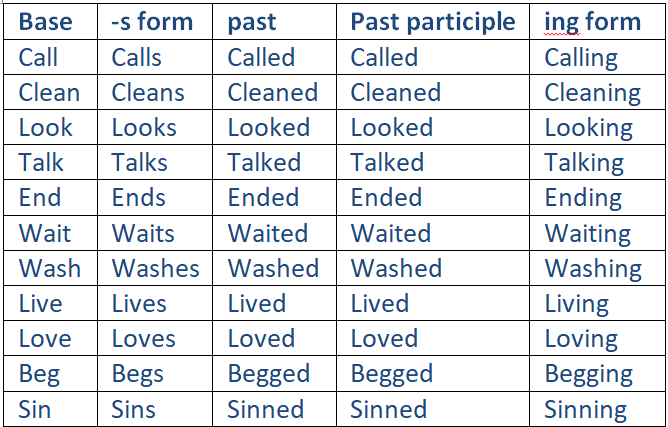


 Grammar
Grammar
 Tenses
Tenses
 Present
Present
 Past
Past
 Future
Future
 Parts Of Speech
Parts Of Speech
 Nouns
Nouns
 Verbs
Verbs
 Adverbs
Adverbs
 Adjectives
Adjectives
 Pronouns
Pronouns
 Pre Position
Pre Position
 Preposition by function
Preposition by function 
 Preposition by construction
Preposition by construction
 Conjunctions
Conjunctions
 Interjections
Interjections
 Grammar Rules
Grammar Rules
 Linguistics
Linguistics
 Semantics
Semantics
 Pragmatics
Pragmatics
 Reading Comprehension
Reading Comprehension|
Read More
Date: 7-4-2021
Date: 7-4-2021
Date: 7-4-2021
|
Regular Verbs in English
A Regular Verb has its base form doesn’t change when we use it in Past Tense or Past Participle. On the other hand, a verb that change its base form is called Irregular Verb. Most of English verbs are regular verbs. They have four different basic forms.
Base form: The normal verb we find in dictionary.
Verb-s form: The form we use when the verb goes with third singular person or thing in Present Tense.
Verb-ed form: When the verb used in Past tense.
Verb-ing form: The form when we use in Continuous form.
Even Regular Verbs don’t change their forms, but there are some rules we must understand and learn to memorize how to use it.
Dropping silent “-e” in the end of the verb.
live – living
glue – gluing
arrive – arriving
dance – dancing
bake – baking
hope – hoping
close – closing
refuse – refusing
Adding “-es” to the verbs
For verbs that end with “-s”, “-ss”, “- sh”, “-ch”, “-x”, “-z”, “-o” affix the suffix -es to the end of the verb. For example:
to box – box – boxes
to catch – catch – catches
to kiss – kiss – kisses
to watch – watch – watches
to wish – wish – wishes
to do – do – does
The doubling rule:
When a verb ends with a letter sequence of consonant-vowel-consonant, double the final consonant.
If the verb is longer than one syllable, double only if the stress falls on the last syllable.
The letters h,w,x,y are never doubled ( fix-fixing).
Example with verb “beg” (b=consonant, e=vowel, g=consonant, stress falls on the last and only syllable /beg/ — double!) :
Example :
Please believe me, I am begging you! (am begging is in the Present Continuous tense)
Change “-y” to “-ies”
For verbs spelled with a final y preceded by a consonant, change the y to an i and then affix the -es suffix. For example:
to apply – apply – applies
to copy – copy – copies
to identify – identify – identifies
to reply – reply – replies
to try – try – tries
Summary
Here is a table of some basic usages of Regular Verbs in English.
notes

Notes - how to use Regular Verbs
Pronunciation differences in past/past participle after /p, s, k, f/ sounds
Pronunciation differences in past/past participle after /t, d/ sounds
Spelling and pronunciation differences in –s form after /s, sh, ch, z/ sounds
Dropping of “silent e” with –ing endings
Doubled consonants after “short” vowel sounds
Spelling differences when “y” is preceded by a consonant
|
|
|
|
دخلت غرفة فنسيت ماذا تريد من داخلها.. خبير يفسر الحالة
|
|
|
|
|
|
|
ثورة طبية.. ابتكار أصغر جهاز لتنظيم ضربات القلب في العالم
|
|
|
|
|
|
|
العتبة العباسية المقدسة تستعد لإطلاق الحفل المركزي لتخرج طلبة الجامعات العراقية
|
|
|